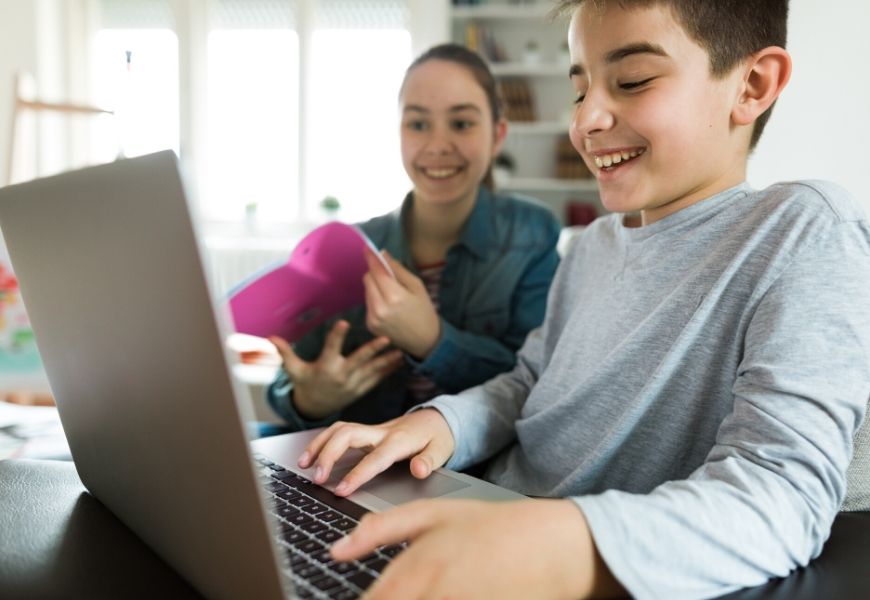Learn online with the help of connectivity
It’s that time of year again. School is still out for students of all ages. Yet, with online learning, you can be in the digital classroom as often and whenever you like.
Whether you’re at school, TAFE or uni, looking to upskill for work or for fun, or a knowledge-hungry senior student, there’s a mountain of free and paid knowledge available online.
And the Connecting Australia† research, commissioned by NBN Co, shows that students of all ages in areas connected to services over the nbn™ broadband access network are particularly taken with online learning.
Studying the stats
According to Connecting Australia†, customers in areas with the nbn™ access network‡ available are keen students more likely to use the internet for non-formal online learning than those yet to connect.
The findings teach us that the rollout of the nbn™ access network has helped to prompt a whole load of non-formal learning, which includes completing courses, learning a new language, watching tutorial videos, and using the internet to quench respective knowledge thirsts.*

And nbn™ connected Australians are twice as likely to already be enrolled in an online course than those not yet connected to the nbn™ access network. Plus, they’re more likely to enrol in the future.
Aussies in nbn™ connected areas are also more likely to dedicate at least one hour a day to non-formal learning online: one in three engage in non-formal learning such as consuming tutorial videos, finishing new courses and studying new languages, compared to one in five non-nbn™ connected people.*
This is likely part of the reason why online education is estimated to boost the Australian economy by up to $1.7 billion in 2021.
Study in the bush
Regional users in nbn™ connected areas are also embracing the studious perks of connectivity.
Connecting Australia data reveals regional Australians connected to services over the nbn™ access network are 1.8 times more likely to dig into non-formal learning online, and 1.4 times more likely to be interested in enrolling in online education down the track, than those in non-nbn™ connected regional areas.
In-home schooling
While traditional home schooling may only have tens of thousands of students (compared to millions at education institutions), connectivity allows for self-paced after-hours learning for every kind of pupil.
In 2005, for instance, only 30 per cent of school-age students used online textbooks; in 2015, that percentage was up to 46.
The rise of high-speed broadband has also led to improved education technology that makes study even easier from home.
And home learning doesn’t have to be boring – this is where sites such as MinecraftEDU.com swing in to make learning fun.

Kids (big and small alike!) can download and play Minecraft: Education Edition, which is all about creativity and problem-solving. Students can even learn to code via gamified learning, which is also the dedicated ‘fun’-ction of teaching kids to code in the free-to-download Rabbids Coding.
For less obviously gamified learning, Nat Geographic Kids is a great resource (and also has lesson-plan inspiration for teachers), while sci-fi-loving kids may appreciate the science facts on NASA Kids’ Club. For kids from pre-kindergarten to grade 6 and beyond, ABCYa is packed with plenty of fun learning activities.
Students of life
Exemplifying the power of online learning, these days, many universities in both Australia and overseas offer their courses online to students of all ages, including free short courses (although in some cases you may need to pay for a completion certificate if you want one).
Just some of the free courses on offer include Backyard Meteorology: The Science of Weather from Harvard University, Tourism and Travel Management from The University of Queensland, and Introduction to Marketing: Tools to Set Enterprises Apart at The University of Edinburgh.
There’s also an extensive range of short courses available via platforms like Lynda, Skillshare and Udemy. Lynda, Skillshare (both subscription-based) and Udemy (purchase individual classes) are more practical and a great resource for those looking to upskill.

For something more focused, MasterClass has a range of courses taught by subject matter experts – who are also household-names – across topics including business, cooking and photography. For example, learn about comedy from Grammy Award-winning Steve Martin, conservation from Dame Jane Goodall, or writing thrillers from The Da Vinci Code author Dan Brown. Classes can be purchased individually or there’s a subscription option to access everything.
Want more free options? You’ll find plenty more of them online. As a starting point, Google Digital Garage has a dedicated range of courses for those seeking to upskill in relevant proficiencies, and for informative-and-fun videos to binge, check out TED-Ed’s expansive library of lessons.
Lifelong learning
Younger generations may have the advantage of online resources being a more common part of day-to-day life, but that may not be the case for those close to or currently enjoying retirement.
The good news is Connecting Australia data shows Australians over 65 are hungry adopters of non-formal education. Thankfully, there are websites like YourLifeChoices that act as a great starting point to making sense of the perks of online learning.
If you’re travelling or just curious to dabble in or master a new tongue, Learn a Language is a great starting point with its free courses. Then you can dig deeper into a new language you like with an online trainer like Babbel.

Websites like U3A Online are designed specifically for older students, with affordable courses across a range of topics that can be completed independently or with the help of a course leader. If all of this sounds too technical, use the Be Connected website to learn about the basics of using devices to get online.
Students of all ages can test their self-paced educational curiosity by slapping ‘how to’ in front of any learnable skill in a search engine to find a wealth of free and premium solutions that can teach a little or a lot. From tying your shoelaces and learning to draw, to creating a website or learning to play guitar, the learning can start or continue whenever you’re connected to the internet.
* An end user’s experience, including the speeds actually achieved over the nbn™ broadband access network, depends on the nbn™ access network technology and configuration over which services are delivered to their premises, whether they are using the internet during the busy period (typically, 7pm to 11pm), and some factors outside of NBN Co’s control (like their equipment quality, software, chosen broadband plan, signal reception, or how their provider designs its network). Speeds may also be impacted by the number of concurrent users on the Fixed Wireless network, particularly during busy periods. Sky Muster™ satellite users may experience latency.
† The Connecting Australia report was commissioned by NBN Co in 2017 through independent research agency AlphaBeta. It combines national census data with an Ipsos survey of 3500 individuals across 1700 postcodes in metropolitan, regional and remote areas, including those connected to the nbn™ broadband access network and those not connected.
‡ The Connecting Australia research compared areas where the rollout of the nbn™ access network is more than 90 per cent complete with areas (defined as an “nbn connected user” for the purpose of the report) where the rollout is less than 10 per cent complete (defined as an “non-nbn connected user” for the purpose of the report).


